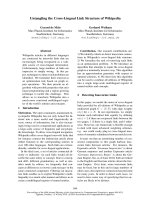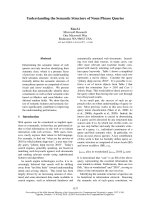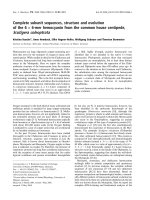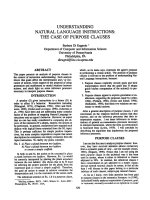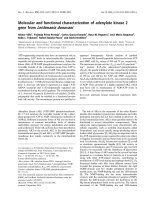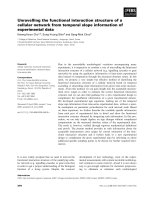Báo cáo khoa học: "Understanding the thematic structure of the Qur’an: an exploratory multivariate approach" pdf
Bạn đang xem bản rút gọn của tài liệu. Xem và tải ngay bản đầy đủ của tài liệu tại đây (99.78 KB, 6 trang )
Proceedings of the ACL Student Research Workshop, pages 7–12,
Ann Arbor, Michigan, June 2005.
c
2005 Association for Computational Linguistics
Understanding the thematic structure of the Qur’an: an exploratory
multivariate approach
Naglaa Thabet
School of English Literature, Language and Linguistics
University of Newcastle
Newcastle upon Tyne, UK, NE1 7RU
Abstract
In this paper, we develop a methodology
for discovering the thematic structure of
the Qur’an based on a fundamental idea in
data mining and related disciplines: that,
with respect to some collection of texts,
the lexical frequency profiles of the
individual texts are a good indicator of
their conceptual content, and thus provide
a reliable criterion for their classification
relative to one another. This idea is
applied to the discovery of thematic
interrelationships among the suras
(chapters) of the Qur’an by abstracting
lexical frequency data from them and then
applying hierarchical cluster analysis to
that data. The results reported here
indicate that the proposed methodology
yields usable results in understanding the
Qur’an on the basis of its lexical
semantics.
1 Introduction
The Qur’an is one of the great religious books of
the world, and is at the heart of Islamic culture.
Careful, well-informed interpretation of the Qur’an
is fundamental both to the faith of millions of
Muslims throughout the world, and to the non-
Islamic world’s understanding of their religion.
There is a long tradition of scholarly quranic
interpretation, and it has necessarily been based on
traditional literary-historical methods of manual
textual exegesis. However, developments in
electronic text representation and analysis now
offer the opportunity of applying the technologies
of newly-emerging research areas such as data
mining (Hand et al., 2001) to the interpretation of
the Qur’an. Studies on computational analyses of
the Qur’an are almost lacking. Contributions to this
field include the development of a morphological
analyser for the Qur’an (Dror et al., 2004).
The Qur’an consists of 114 chapters called suras
which range in length from the shortest, Al-
Kawthar, consisting of 4 ayat (verses) to the
longest, Al-Baqarah, consisting of 286 ayat. There
is no obvious reason why the suras are sequenced
as they are in the text. They are not in
chronological order, and seem, in fact, to be
ordered roughly by length, from longest at the
beginning of the text to shortest at the end. Given
this, apparently arbitrary sequencing, one of the
first steps in interpreting the Qur’an as a whole
must be to discover thematic interrelationships
among the suras. The present paper proposes a
methodology for doing this using exploratory
multivariate analysis.
The paper is in five parts; the first part is the
introduction. The second presents the quranic text
and the data preparation prior to the analysis. The
third part deals with the application of cluster
analysis techniques to the Qur’an and the
interpretation of the results. The fourth part draws
the conclusion and suggests future research to be
undertaken.
2 Data
The data for this study is based on an electronic
version of the Qur’an produced by Muslimnet
1
.
This version is a Western alphabetic transliteration
of the Arabic orthography. The data is
transliterated into Latin based ASCII characters,
mostly with single-symbol equivalents of the
Arabic phonemes and by replacing diacritics and
1
7
glyphs which represent short vowels in Arabic
orthography with appropriate Roman letters.
A frequency matrix F is constructed in which the
rows are the suras, the columns are lexical items,
and every cell F
ij
contains an integer that
represents the number of times lexical item j
occurs in sura i. Construction of such a matrix is
straightforward in principle, but in practice some
well known issues arise.
2.1 Tokenization
Given that one wants to count words, what is a
word? The answer is surprisingly difficult, and is a
traditional problem both in linguistics and in
natural language processing (Manning and Shütze,
1999). Even confined to written language, as here,
two issues arise:
• Word segmentation: In English text, the
commonsensical view that a word is the
string of letters bounded by punctuation
and/or white space is quite robust, but it is
less so for other languages.
• Stemming: In languages with a significant
element of morphological elaboration of
words stems, do the various morphological
variants of a given stem count as different
words?
For present purposes, the words segmentation
problem is easily resolved in that the Qur’an’s
orthography is such that words can be reliably
identified using the ‘string of letters between
punctuation and/or white space’ criterion. With
regard to stemming, morphological variants are
treated as single word types, and to achieve this,
the electronic text of the Qur’an was processed
using a purpose-built stemmer whose
characteristics and performance are described in
Thabet (2004).
2.2 Keyword selection
Function words like determiners and prepositions
were removed from the text, and only content
words were retained. In addition, the (many) words
with frequency 1 were removed, since these cannot
contribute to determination of relationship among
suras.
2.3 Standardization for text length
The introduction noted that the suras vary in length
from fewer than a dozen to several thousand words.
The following plot of number of content words per
sura, sorted in order of descending magnitude.
“Figure 1. Plot of number of words per sura”
Clearly, given a word with some probability of
occurrence, it is more likely to occur in a long text
than a short one. In order to compare the suras
meaningfully on the basis of their word frequency
profiles, the raw frequencies have to be adjusted to
compensate for sura length variation. This was
done on the following basis:
() ()
⎟
⎠
⎞
⎜
⎝
⎛
×=
l
FfreqFfreq
ijij
µ
'
where freq' is the adjusted frequency, F
ij
is the
value at the (i,j) coordinates of the data matrix F,
freq is the raw frequency, µ is the mean number of
words per sura across all 114 suras, and l is the
number of words in sura i.
That said, it has also to be observed that, as text
length decreases, so does the probability that any
given word will occur even once in it, and its
frequency vector will therefore become
increasingly sparse, consisting mainly of zeros.
Because 0 is non-adjustable, functions that
compensate for variable text length generate
increasingly unreliable results as length decreases.
In the present application, therefore, only relatively
long suras are considered for analysis, and more
specifically those 24 containing 1000 or more
content words.
Sura name Words Sura name Words
Al-Baqarah 5739 Al-Israa 1464
Al-Imran 3316 Al-Kahf 1489
Al-Nisa 3543 Ta-Ha 1265
Al-Maidah 2681 Al-Anbiyaa 1077
Al-An'am 2895 Al-Hajj 1195
Al-A'raf 3127 Al-Nur 1236
Al-Anfal 1156 Al-Shu'araa 1208
8
Al-Tawba 2345 Al-Naml 1069
Yunus 1732 Al-Qasas 1332
Hud 1809 Al-Ahzab 1239
Yusuf 1665 Al-Zumr 1107
Al-Nahl 1729 Ghafir 1156
“Table 1. Suras with more than 1000 words”
The choice of 1000 as the length threshold is
arbitrary. Arbitrariness does no harm in a
methodological paper such as this one. Clearly,
however, any legitimate analysis of the Qur’an
using this methodology will have to face the
problem of which suras, if any, to exclude on
length grounds in a principled way.
2.4 Dimensionality reduction
After function words and words with frequency 1
were eliminated and morphological variants
stemmed, 3672 significant ‘content’ words
remained, requiring a matrix with 3672 columns.
Given only 24 data points, this results in an
extremely sparsely populated data space whose
dimensionality should be reduced as much as
possible consistent with the need to represent the
data domain adequately. For a discussion of
dimensionality issues in data analysis see
Verleysen (2003). To do this, the variances for all
3672 columns of the frequency matrix F were
calculated, sorted in decreasing order of magnitude,
and plotted:
“Figure 2. Plot of variances for 3762 columns”
This is what one would expect from the typical
word frequency distribution in natural language
text articulated by Zipf’s Law (Manning and
Shütze, 1999; 20-29): almost all the variance in the
data is concentrated in a small number of variables
–the 500 or so on the left. The variance in the
remainder is so small that it cannot contribute
significantly to differentiating the data matrix rows
and, therefore, can be disregarded. The matrix is
thus truncated to 500 variables / columns, resulting
in a 24 x 500 matrix for cluster analysis.
3 Analysis
3.1 Hierarchical cluster analysis
Cluster analysis aims to identify and graphically
represent nonrandomness in the distribution of
vectors in a data space such that intra-group
distance is small relative to the dimensions of the
space, and inter-group distance is relatively large.
Detailed accounts of hierarchical cluster analysis
are in Everitt (2001), Gordon (1999; 69-109), and
Gore (2000). For briefer discussions see Dunn and
Everitt (2001; 125-160), Hair et al. (1998; 469-
518), Flynn et al. (1999; 275-9), Kachigan (1991;
261-70), Oakes (1998; 110-120). There are two
main varieties: hierarchical and nonhierarchical.
The former aims not only to discover and
graphically represent clusters, but also to show
constituency relations among data items and data
item clusters as ‘dendrograms’ or trees.
Hierarchical analysis uses relative proximity
among vectors as the basis for clustering, where
proximity can be measured in terms either of
similarity or of distance; distance is most often
used, and is adopted here. Assuming the existence
of a data matrix containing numerical values such
as the one described above, construction of a
distance-based cluster tree is a two-stage
procedure. In the first step, a table of distances
between data items, that is, between row vectors of
the data matrix, is generated. A frequently used
measure is the Euclidean; there the distance
between vectors A and B is calculated using the
well known formula:
22
))(())(()( ylengthxlengthzlength +=
, but there
are many others as in Gordon (1999; 15-3) and
Flynn et al. (1999; 271-4).
The second step then uses the distance table to
build clusters with the following generic algorithm:
• Initially, every data vector is its own
cluster.
• Using as many steps as necessary, at each
step combine the two nearest clusters to
form a new, composite cluster, thus
reducing the number of clusters by 1.
9
• When only one cluster remains,
incorporating all the cases in the distance
matrix, stop.
An example of a tree generated by this procedure
follows in the next section.
3.2 Cluster analysis of the quranic data
The above generic clustering algorithm glosses
over an important point: determination of distances
between data items is given by the distance table,
but the distances between composite clusters is not,
and needs to be calculated at each step. How are
these distances calculated? There is no single
answer. Various definitions of what constitutes a
cluster exist, and, in any given application, one is
free to choose among them. The problem is that
the numerous combinations of distance measure
and cluster definition available to the researcher
typically generate different analyses of the same
data, and there is currently no objective criterion
for choosing among them. This indeterminacy is,
in fact, the main drawback in using hierarchical
clustering for data analysis. The present discussion
sidesteps this important issue on the grounds that
its aim is methodological: the intention at this
stage of research is not to present a definitive
cluster analysis of the Qur’an, but to develop an
approach to doing so. One particular combination
of distance measure and cluster definition was
therefore chosen at random and applied to the data:
squared Euclidean distance and Ward’s Method.
The result was as follows (the A - D labels on the
left are for later reference):
“Figure 3. Tree generated by cluster analysis”
3.3 Interpretation
Given that the lengths of the vertical lines in the
above tree represent relative distance between
subclusters, interpretation of the tree in terms of
the constituency relations among suras is obvious:
there are two main subclusters A and B; A consists
of two subclusters C and D, and so on. Knowing
the constituency structure of the suras is a
necessary precondition for understanding their
thematic interrelationships –the object of this
exercise—but it is not sufficient because it
provides no information about the thematic
characteristics of the clusters and the thematic
differences between and among them. This
information can be derived from the lexical
semantics of the column labels in the data matrix,
as follows.
Each row in the data matrix is a lexical
frequency profile of the corresponding sura. Since
hierarchical analysis clusters the rows of the data
matrix in terms of their relative distance from one
another in the data space, it follows that the lexical
frequency profiles in a given cluster G are closer to
one another than to any other profile in the data set.
The profiles of G can be summarized by a vector s
whose dimensionality is that of the data, and each
of whose elements contains the mean of the
frequencies for the corresponding data matrix
column:
(
)
nFs
ni
jij
/
1
,
∑
=
=
where j is the index to the jth element of s, i
indexes the rows of the data matrix F, and n is the
total number of rows in cluster G. If s is interpreted
in terms of the semantics of the matrix column
labels, it becomes a thematic profile for G: relative
to the frequency range of s, a high-frequency word
indicates that the suras which constitute G are
concerned with the denotation of that word, and
the indication for a low-frequency one is the
obverse. Such a thematic profile can be constructed
for each subcluster, and thematic differences
between subclusters can be derived by comparing
the profiles.
The general procedure for thematic
interpretation of the cluster tree, therefore, is to
work through the levels of the tree from the top,
constructing and comparing thematic profiles for
the subclusters at each level as far down the tree as
is felt to be useful.
10
By way of example, consider the application of
this general procedure to subtrees A and B in the
above cluster tree. Two mean frequency vectors
were generated, one for the component suras of
cluster A, and one for those of cluster B. These
were then plotted relative to one another; the solid
line with square nodes represents cluster A, and the
dotted line with diamond nodes cluster B; for
clarity, only the 50 highest-variance variables are
shown, in descending order of magnitude from the
left:
“Figure 4. Initial plot of groups A and B”
The suras of cluster A are strikingly more
concerned with the denotation of variable 1, the
highest-variance variable in the Qur’an, than the
suras of cluster B. This variable is the lexical item
‘Allah’, which is central in Islam; the disparity in
the frequency of its occurrence in A and B is the
first significant finding of the proposed
methodology.
The scaling of the ‘Allah’ variable dominates
all the other variables. To gain resolution for the
others, ‘Allah’ was eliminated from the lexical
frequency vectors, and the vectors were re-plotted:
“Figure 5. Re-plotting of groups A and B”
Awareness of the historical background of the
Qur’an’s revelation to Mohamed is crucial at this
point of interpretation. The suras revealed to
Mohamed before his migration to Madinah are
called Makkan suras, whereas those sent down
after the migration are called Madinan. Makkan
suras stress the unity and majesty of Allah,
promise paradise for the righteous and warn
wrongdoers of their punishment, confirm the
prophethood of Mohamed and the coming
resurrection, and remind humanity of the past
prophets and events of their times. On the other
hand, the Madinan suras outline ritualistic aspects
of Islam, lay down moral and ethical codes,
criminal laws, social, economic and state policies,
and give guidelines for foreign relations and
regulations for battles and captives of war. The
results emerging from the initial clustering
classification in figure 3 highlighted such thematic
distiction. All the suras in cluster A are Madinan
suras (apart from ‘Al-Nahl’ and ‘Al-Zumr’ which
are Makkan suras; yet they do contain some verses
that were revealed in Madina). The 13 suras which
compose cluster B are all Madinan suras. The
distribution of the variables (keywords) in figure 5
is also highly significant, e.g. variable 1 ‘qAl’ (said)
is prevalent in the suras of cluster B. The suras of
this group contain many narratives which illustrate
important aspects of the quranic message, remind
of the earlier prophets and their struggle and
strengthen Prophet Mohamed’s message of Islam.
This signifies the use of the verb ‘qAl’ as a
keyword in narrative style. Variable 4 ‘qul’ (say,
imperative) is more frequent in group B than group
A. Most of the passages of these Makkan suras
start with the word ‘qul’, which is an instruction to
Prophet Mohamed to address the words following
this introduction to his audience in a particular
situation, such as in reply to a question that has
been raised, or an assertion of a matter of belief.
The use of this word was appropriate with
Mohamed’s invitation to belief in God and Islam in
Makkan suras. Variable 5 ‘mu/min’ (believers),
variable 8 ‘Aman’ (believe) and variable 24 ‘ittaq’
(have faith) highly occur in group A. These are the
Madinan suras in which prophet Mohamed
addresses those who already believed in his
message and hence focusing on introducing them
to the other social and ethical aspects of Islam.
Other variables prevelant in group B are variables
14 and 28 ‘AyAt , Ayat’ (signs/sign). The use of
11
the two words was very important for Prophet
Mohamed in the early phase of Islam in Makkah.
He had to provide evidence and signs to people to
support his invitation to belief in Allah and Islam.
The same procedure of clustering can be applied
to the subclusters of A and B. Again, the scaling of
Allah’ dominates, and removing it from the mean
frequency vectors gives better resolution for the
remaining variables. Plotting the lexical frequency
vectors for C and D, for example, yields the
following:
“Figure 6. Plot of groups C and D”
Results from figure 6 are also supportive of the
thematic structure of each group. Suras of group C
are more abundant in the use of narratives and
addressing Mohamed to provide evidence of his
message to people. Suras of group B are more
concerned with addressing believers about the
reward for their righteous conduct. Occurrences of
relative variables to those themes are indicative of
such distinction.
4 Conclusion and future directions
The above preliminary results indicate that
construction and semantic interpretation of cluster
trees based on lexical frequency is a useful
approach to discovering thematic interrelationships
among the suras that constitute the Qur’an. Usable
results can, however, only be generated when two
main issues have been resolved:
• Standardization of the data for variation in
sura length, as discussed in section (2.3)
• Variation in tree structure with different
combinations of distance measure and
cluster definition, as discussed in section
(3.2)
Work on these is ongoing.
To conclude, hierarchical cluster analysis is
known to give different results for different
distance measure / clustering rule combinations,
and consequently cannot be relied on to provide a
definitive analysis. The next step is to see if
interpretation of the principal components of a
principal component analysis of the frequency
matrix yields results consistent with those
described above. Another multivariate method to
be applied to the data is multidimensional scaling.
In the longer term, the aim is to use nonlinear
methods such as the self organizing map in order
to take account of any nonlinearities in the data.
References
Dror, J., Shaharabani, D., Talmon, R., Wintner, S.
2004. Morphological Analysis of the Qur'an.
Literary and Linguistic Computing, 19(4):431-452.
Dunn, G. and Everitt, B. (2001). Applied Multivariate
Data Analysis, 2
nd
ed. Arnold, London.
Everitt, B. (2001). Cluster Analysis, 4
th
ed. Arnold,
London.
Flynn, P., Jain, A., and Murty, M. (1999). Data
clustering: A review. In: ACM Computing Surveys
31, 264–323.
Gordon, A. (1999). Classification, 2
nd
ed. Chapman
& Hall, London.
Gore, P. (2000). Cluster Analysis. In H. E. A. Tinsley
& S. D. Brown (Eds.), Handbook of applied
multivariate statistics and mathematical modeling
(pp. 297-321). Academic Press, San Diego, CA
Hair, H., Anderson, J., Black, W. and Tatham, R.
(1998). Multivariate Data Analysis, 5
th
ed.
Prentice-Hall International, London.
Hand, D., Mannila, H., Smyth, P. (2001). Principles
of Data Mining, MIT Press.
Kachigan, S. (1991). Multivariate Statistical Analysis.
A conceptual introduction. Radius Press, New
York
Manning, C. and Schütze, H. (1999). Foundations of
Statistical Natural Language Processing.
Cambridge, Mass, MIT Press.
Oakes, M. (1998). Statistics for Corpus Linguistics.
Edinburgh University Press, Edinburgh
Thabet, N. (2004). “Stemming the Qur’an”. In
Proceedings of Arabic Script-Based Languages
Workshop, COLING-04, Switzerland, August 2004.
Verleysen, M. (2003). Learning high-dimensional
data. In: Limitations and future trends in neural
computation. IOS Press, Amesterdam, pp141-162.
12




